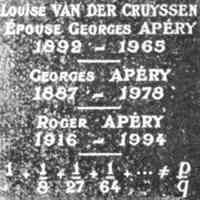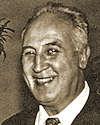Mathematical Anecdotes
"Bombieri's Napkin Problem" :
A Botched Challenge (1979)
During the 1979 Queen's Number Theory Conference
in Kingston (Ontario),
Enrico Bombieri (Fields Medalist in 1974)
offered in jest a challenge analogous to
Fermat's Last Theorem
to some colleagues he was having diner with, including
Roger Apéry and Michel Mendès-France (who
reported
the anecdote).
Prove that there are no nontrivial solutions,
in positive integers,
to the following equation (involving
choice numbers):
C(x,n) + C(y,n) = C(z,n)
The next morning, Apéry offered a solution:
n = 3, x = 10, y = 16, z = 17.
Bombieri just replied, with a straight face: "I said nontrivial."

The puzzle is much older than this anecdote:
It is casually mentioned in the popular book
Tomorrow's Math: Unsolved Problems for the Amateur (1972 edition, at least)
by Dr.
Charles Stanley Ogilvy
(1913-2000)
who echoes a misleading presentation that could easily have fooled the likes of Bombieri
or Mendès-France in an era when computer access wasn't easy...
2006-01-30: Some
Solutions to
C(x,n) + C(y,n) = C(z,n)
| n | x | y | z |
|---|
| n |
2n-1 | 2n-1 | 2n |
|---|
| 1 |
x | y | x+y |
|---|
| 2 |
3m+3 | 4m+3 | 5m+4 |
|---|
| 3m+4 | 4m+6 | 5m+7 |
| 5m+5 | 12m+10 | 13m+11 |
| 5m+6 | 12m+15 | 13m+16 |
| 15m+10 | 8m+5 | 17m+11 |
| 15m+21 | 8m+12 | 17m+24 |
| x | ½ x(x-1) | ½ x(x-1) + 1 |
| 3 |
10 | 16 | 17 |
|---|
| 22 | 56 | 57 |
| 32 | 57 | 60 |
| 41 | 72 | 76 |
| 63 | 104 | 111 |
| 86 | 92 | 112 |
| 36 | 120 | 121 |
| 4 |
132 | 190 | 200 |
|---|
| 6 |
14 | 15 | 16 |
|---|
| 19 | 19 | 21 |
| 35 |
118 | 118 | 120 |
|---|
| 40 |
103 | 104 | 105 |
|---|
C(103.40) = 61218182743304701891431482520 is one of the rare numbers found 5 times or
more in Pascal's triangle (A003015).
Likewise for C(14,6) = 3003.
See entertaining video by Zoe Griffiths (9:05, 2020-04-19).
With y=x+i and z=x+j (i<j) we may factor out C(x,n-j) to obtain an equation
of degree j in x and n.
The second line of the above table (n=1) corresponds to j=1.
For j=2, we obtain two quadratic
diophantine equations (i=0 or i=1)
respectively yielding the following two infinite families of explicit solutions:
1)
When 8n2+1
is a perfect square (q2 )
a solution is: x = ½ (4n-3+q),
y = x, z = x+2
Such values of n (and those of q) obey the recurrence:
ai+2 = 6 ai+1 - ai
| n |
1 | 6 | 35 | 204 | 1189 | 6930 |
40391 | 235416 | 7997214 |
|---|
| x |
2 | 19 | 118 | 695 | 4058 | 23659 |
137902 | 803759 | 27304195 |
|---|
| y |
2 | 19 | 118 | 695 | 4058 | 23659 |
137902 | 803759 | 27304195 |
|---|
| z |
4 | 21 | 120 | 697 | 4060 | 23661 |
137904 | 803761 | 27304197 |
|---|
2)
If 5n2-2n+1
is a square (q2 ) then a solution is:
x = ½ (3n-3+q),
y = x+1, z = x+2
Such values of n obey the recurrence:
ai+2 = 7 ai+1 - ai - 1
(Every fourth Fibonacci number is a value of q : 2, 13, 89, 610, 4181, 28657...)
| n |
1 | 6 | 40 | 273 | 1870 | 12816 |
87841 | 602070 | 4126648 |
|---|
| x |
1 | 14 | 103 | 713 | 4894 | 33551 |
229969 | 1576238 | 10803703 |
|---|
| y |
2 | 15 | 104 | 714 | 4895 | 33552 |
229970 | 1576239 | 10803704 |
|---|
| z |
3 | 16 | 105 | 715 | 4896 | 33553 |
229971 | 1576240 | 10803705 |
|---|
Bombieri's Napkin Problem is now discussed on the "Math Overflow" forum :-)
For undisclosed reasons,
Wadim Zudilin states for the record that he "personally doesn't like" the above presentation :-(
|

![]() By tantalizing contrast, Euler showed,
in 1735, that the value z(2n)
at an even integer 2n
is a rational multiple of the 2n-th power of p,
starting with
z(2) = p2/6
(the former Basel Problem) and
z(4) = p4/90 .
By tantalizing contrast, Euler showed,
in 1735, that the value z(2n)
at an even integer 2n
is a rational multiple of the 2n-th power of p,
starting with
z(2) = p2/6
(the former Basel Problem) and
z(4) = p4/90 .
